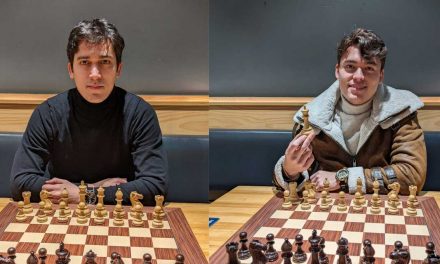On March 8 – 10th, 124 high school students competed in the 2019 Texas State Scholastic Championship in Houston, Texas. After five rounds, Sam Rose (1984) found himself on board 2 with black, facing NM Bovey Liu (2362), the highest rated player in the tournament and the 2016 U.S. Junior Open Champion. Normally, a Class A player would feel trepidation having black against such a strong and accomplished National Master in a must-win situation.
Both players had 4.5/5 points and were tied for 3rd place with two rounds remaining. However, Sam felt confident playing his specialty, the Caro-Kann Defense, against the Master. This was in large part due to Sam’s work with his coach, NM Michael Richards, on absorbing the positional play of Tigran Petrosian and Aron Nimzowitsch. The result was a “cat and mouse” positional game that is instructive and inspirational.
[Event “2019 Texas State Scholastic Ch.”]
[Site “Houston, TX”]
[Date “2019.03.10”]
[Round “6”]
[White “Bovey Liu”]
[Black “Sam Rose”]
[Result “0-1”]
[ECO “B11”]
[WhiteElo “2362”]
[BlackElo “1984”]
[PlyCount “98”]
Annotations by Sam Rose
1. e4 c6 2. Nf3 d5 3. Nc3 Bg4 {[%cal Yd2d3] The Two Knights Variation. Although this system may not look promising, it keeps the pawn structure flexible as White can build up a controlled d2-d4 or play it like a King’s Indian Attack with d2-d3 and even g2-g4.} 4. h3 Bxf3 {Black is willing to give up the bishop-pair and counts on the closed pawn structure to dominate the two bishops.} 5. Qxf3 Nf6 6. d3 e6 7. Bd2 Qb6 $5 {A recommendation of Jovanka Houska based on the …Bb4 idea, but encouraging White to refrain from the idea of pushing the g-pawn.} ({The critical line follows:} 7… Nbd7 8. g4 Bb4 9. g5 Ng8 10. d4 $14) 8. O-O-O Bb4 9. e5 Nfd7 10. Qg3 {Attacking the g7-pawn, but White can no longer play g2-g4.} g6 11. h4 Bxc3 $5 {An idea that may seem completely absurd, but has some positional soundness to it. Black gives up his dark-squared bishop to gain some space and to create blooming prospects for his two knights on the light squares.} 12. Bxc3 d4 13. Bd2 h5 $11 14. Qg5 $6 ({Better is} 14. f4 {and if Black plays mechanically with} c5 {then Black will be rudely awakened with} (14… Nc5 {is aimed at preventing f5.}) 15. f5 $1 {blasting Black’s kingside to pieces.} exf5 16. e6 $1 Nf8 17. exf7+ Kxf7 18. Qe5 $16) 14… c5 15. a3 $6 {White musn’t play slow if he wants any sliver of advantage. He must charge on the kingside with moves such as g4 and f4.} Nc6 16. Re1 Qd8 $1 {Black threatens to go into a better ending.} 17. Qxd8+ Kxd8 18.f4 Ne7 {The Black knight begins its expedition of preventing all White counterplay on the kingside via Ne7-f5-h6-g4.} 19. Be2 Nf5 20. Bf3 Rb8 21. Rd1 Ke7 22. Be4 Nh6 {We shouldn’t allow White to exchange his bishop for our dominating knights.} 23. Be1 b6 24. c3 {A last try to open lines for his suffocating dark-squared bishop.} Rbc8 25. Bf3 Ng4 {Our knight has reached its dream destination as it cannot be captured because of the opening of the h-file.} 26. Kb1 Ne3 27. Rd2 dxc3 $1 {Taking on c3 opens the d-file, potentially weakening the d3-pawn and allows …Nd5 forcing the exchange of minors. This vacates the e6 and f5 squares for the king and a potential knight blockade on e6.} 28. bxc3 Nd5 29. Bxd5 exd5 30. Bf2 Ke6 31. a4 Kf5 32. g3 Rhd8 33. Re1 Nf8 34. Kb2 {Black now achieves his dream position where the Black knight shines over the opposing bishop.} Ne6 $15 {Diagram [#]} 35. Red1 c4 36.Kc2 {Black has under 2 minutes remaining on his clock and decides to breakthrough with} d4 $1 {Diagram [#]} 37. dxc4 Rxc4 38. Bxd4 Nxd4+ $6 (38… Rxa4 {can fight for further advantage and allows no drawing chances for the opposing side.} 39. Kb3 b5 $17) 39. Kb2 $4 ({White is better off in the ending as he has some drawing chances.} 39. Rxd4 Rdxd4 40. Rxd4 Rxd4 41. cxd4 Ke4 42.Kc3 Kd5 43. Kd3 a6 44. Kc3 b5 45. axb5 axb5 46. Kb4 Kxd4 47. Kxb5 Kd5 48. Kb6 Ke4 49. Kc6 Kf3 50. Kd7 Kxg3 51. Ke7 Kxf4 52. Kxf7 Kxe5 53. Kxg6 Kf4 54. Kxh5 Kf5 $11) 39… Rxa4 40. cxd4 Rd5 {Blockading the d-pawn from further advancing.} 41. Kb3 b5 42. Rc1 Raxd4 {Black is winning.} 43. Rxd4 Rxd4 44. Rc7 Ke6 45.Rc6+ Ke7 46. Rf6 {The White rook may look good there, but performs no role in the position.} Rd3+ 47. Kb4 Rxg3 48. Kxb5 Rg4 49. f5 Re4 $1 0-1



